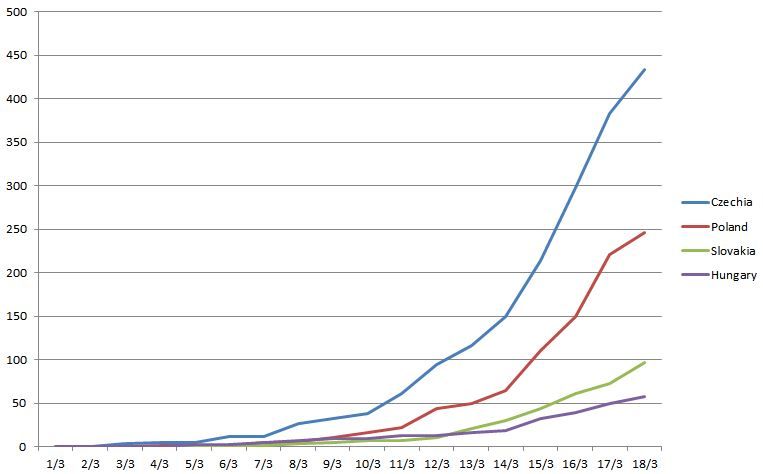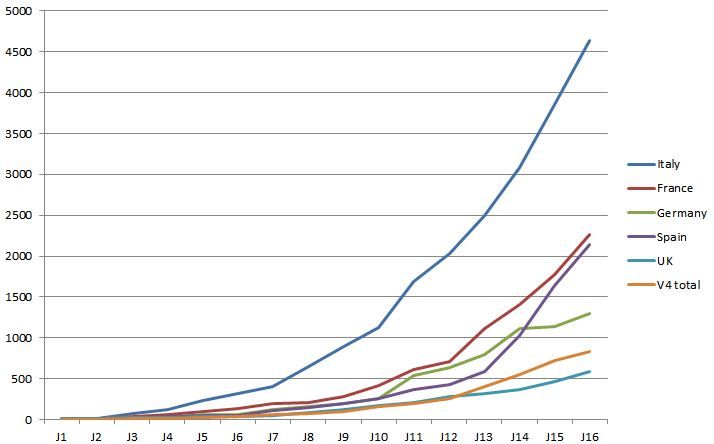By Olivier Bault.
Visegrád Group – With the Chinese 2019 coronavirus having arrived on their territory in early March, we will have to wait at least a few weeks before we can assess the effectiveness of measures taken at an early stage of the epidemic by all four countries of the Visegrád Group (V4): Poland, the Czech Republic, Slovakia and Hungary. Before them, Italy, Germany, France, Spain and the United Kingdom had made the choice to defer for as long as possible measures such as the closure of schools and other places of potential contamination, or the closure of national borders. As of March 17, with already more than 1500 patients diagnosed with COVID-19, the United Kingdom had not yet taken any of these measures. France only closed its schools from March 16, when it already had more than 5000 known cases of the disease. Germany had almost as many people diagnosed with COVID-19 when it decided to close its borders on the same day, and Spain took containment measures at national level from March 16, when it had nearly 8000 people known to be infected with SARS-CoV-2. Italy enforced similar measures on March 10, with over 9000 patients already diagnosed with the coronavirus.
Having been the first V4 country to report cases of COVID-19 on its territory, with three patients reported on March 1 on their return from Italy (their diagnosis was eventually confirmed on March 3), the Czech Republic was still the most affected country of the block by March 18, with 434 reported cases (but still no deaths). On March 12, with 94 reported cases, the Czech government declared a state of emergency and closed its schools and universities, imposing compulsory quarantine for persons returning from Italy. All sporting, cultural and religious events had already been banned on March 10. As early as March 14 most stores were closed (excluding essential oneslike food stores and pharmacies) and all gatherings were prohibited. Since March 16 the country’s borders have been closed in both directions (outward and inward), and Prague has imposed a generalised containment of the population with limitations on freedom of movement, like in Italy.
The second most affected country of the block, with 246 diagnosed cases and 5 deaths as of March 18, was Poland, where the first patient – who had been infected with COVID-19 in Germany – was reported on March 4. Poland closed its schools, universities, cultural venues, shopping malls, swimming pools, etc. starting from March 11 (with 22 cases diagnosed) and its borders on March 15 (with 111 cases diagnosed). Just as in the remaining V4 countries, the rapid increase in the amount of testings being done for COVID-19 naturally leads to an increase in cases being detected, and the health minister indicated that it would be necessary to wait 10 to 14 days to observe the effect of the measures put in place in counteracting the exponential growth in the number of COVID-19 diagnoses.
Slovakia was the last of the Visegrád Four to report its first case of COVID-19, doing so on March 7 (Hungary reported its first case on March 5), but it ranked third in terms of the number of patients known to have the coronavirus as of March 18, with 97 cases (and still no deaths). Bratislava closed the country’s borders as early as March 13, with only 21 reported cases on the eve of the implementation of that measure. Schools, swimming pools, commercial centres and ski resorts have also been closed since that date. The government had already declared a state of emergency from Thursday, March 12.
Last, Hungary, with 58 reported cases (and one death) as of March 18, had closed its schools two days before, after declaring a state of emergency. Since March 17, recreational facilities have been shut and the country’s borders have been closed to non-resident foreigners, as in the other countries of the Visegrád Group.
Number of patients diagnosed with COVID-19.
Although they recorded their first cases a week later than the beginning of the epidemic in the United Kingdom, Germany, France and Spain, the Visegrád Four were the first to react with strong measures, preferring to follow the example of countries of South East Asia, which for the time being seem to have succeeded in curbing the epidemic, rather than that of Western Europe, where as of March 19 governments seemed to have lost control of the situation. It will be very interesting to compare the evolution of the disease in the weeks to come. If the V4 countries succeed better and faster in warding off the epidemic, with fewer casualties in spite of their poorer health systems, it will shed a very unfavourable light on the capitals of Western Europe.
The first 16 days of the progression of the epidemic in Italy (from February 21), France (from February 26), Germany (from February 25), Spain (from February 26), the United Kingdom (from February 27) and the four countries of the Visegrád Group (from March 3).Figures are plotted from the day when the number of diagnosed cases began to increase daily in each respective country, based on the WHO’s daily reports (https://www.who.int/emergencies/diseases/novel-coronavirus-2019/situation-reports).






